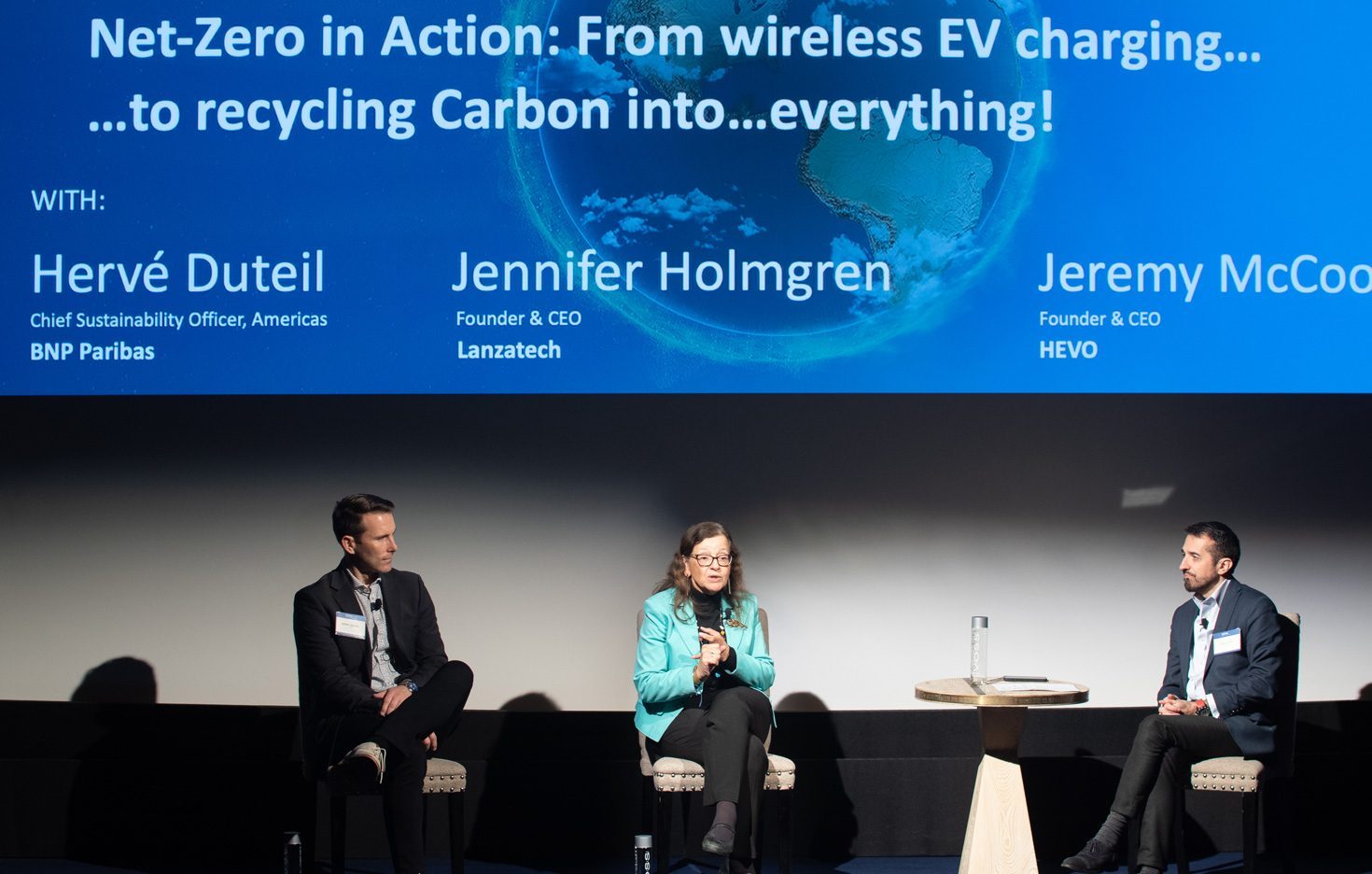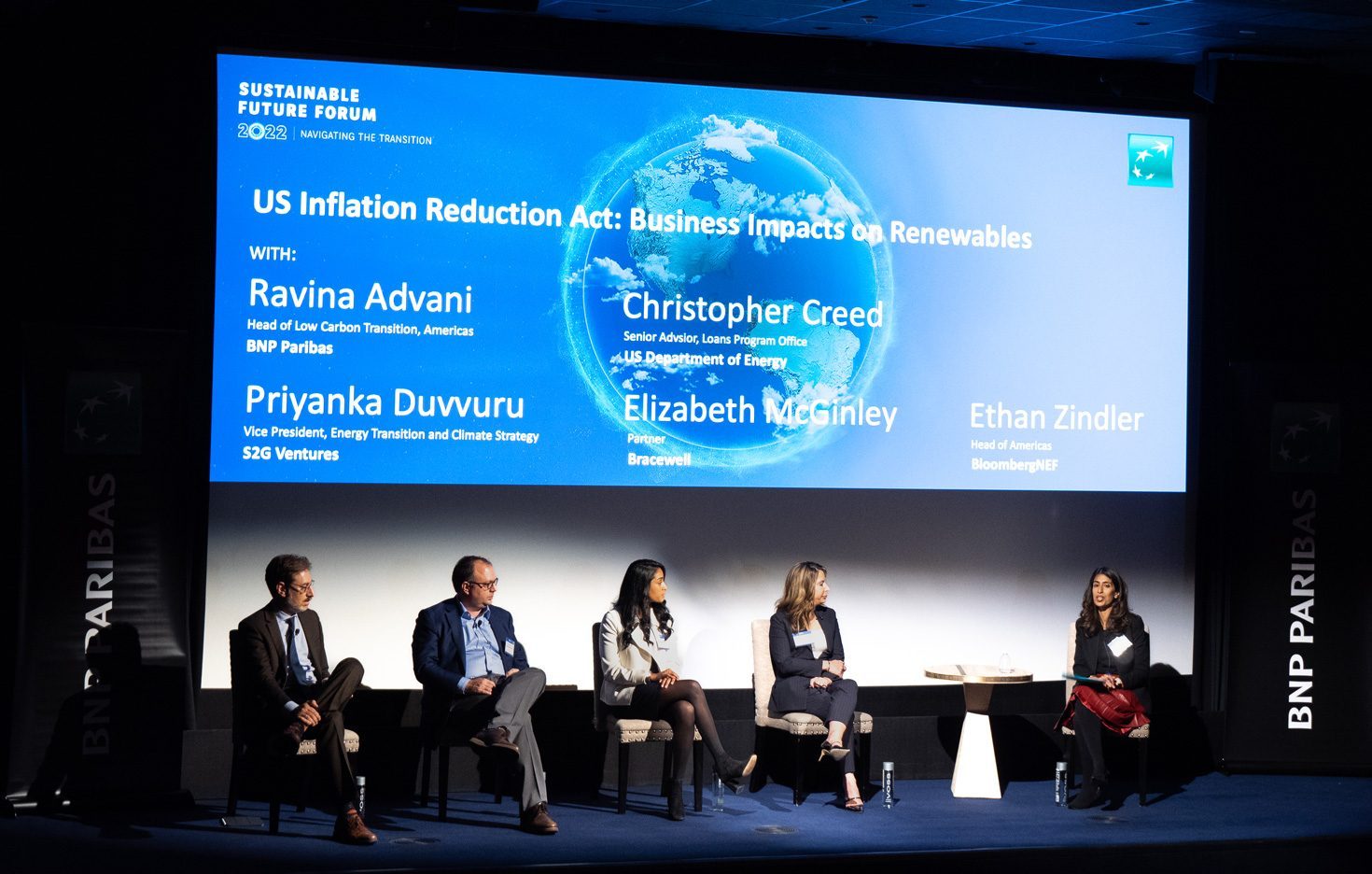District energy: green loan supports Vicinity’s low carbon commitment
A new green loan will drive the decarbonisation of district energy systems in cities across the US.
The inaugural US Renewables Summit explored how regulation and innovation are sparking a clean energy transition stateside.

The landmark Inflation Reduction Act (IRA), along with other climate-focused regulation, has accelerated investment in a clean energy transition across the US. The ambitious scope of recent US policy has revealed the gaping need for funding to reach the nation’s goal of net zero greenhouse gas emissions by 2050, with estimates putting the required clean energy investment figure at some US$4 trillion per year globally by 2030.
Against this backdrop, experts, thought leaders and entrepreneurs gathered at BNP Paribas’ Inaugural US Renewables Summit, part of the Bank’s annual Sustainable Future Forum in New York City, to provide their unique perspectives on some of the key factors and trends on the journey to net zero stateside. The event also explored the rising momentum among capital providers, investors and entrepreneurs to collaborate on driving decarbonisation at scale through emerging clean energy technologies.
The summit included key experts from across the public and private sectors, including BloombergNEF, The US Department of Energy, S2GVentures, Bracewell, and Columbia University’s Climate School.
The implementation of the IRA, together with the Bipartisan Infrastructure Law and the CHIPS & Science Act, together introduce approximately US$2 trillion in climate-related spending over the next 10 years. As a result, corporations, asset managers and lenders are eyeing investments in a promising range of clean energy projects aimed at curbing climate change. Federal spending is shown to be a big economic incentive for private investment.
Outside of those direct funds, another attractive incentive for corporates under the IRA is a generous increase in uncapped tax credits, including a dramatic expansion of tax incentives to invest in carbon capture and storage technology. As long as climate projects meet the terms outlined in the IRA, the government will provide the credits. This also includes a new production tax credit offered to incentivise investment in clean hydrogen technology, the cleanest methods of hydrogen release.
Speakers at the Renewables Summit also underlined how partnerships between the public and private sectors will be critical to the growth and adoption of clean energy and climate technologies. In the case of hydrogen, for example, a lack of regulatory certainty about funding standards for green hydrogen projects has meant that outside investments have been lagging. Panellists agreed that to date, most hydrogen projects are being financed internally by corporations themselves.
Another area that could benefit from closer ties between sectors is government lending for green corporate energy projects. While approximately US$370 billion has been authorised for clean energy and infrastructure loans under the IRA – the single largest investment in climate and energy in American history – federal lending officers cannot act on deploying those funds until asset managers, entrepreneurs and corporations apply for loans.
Therefore, US government lending officials are making it a priority to inform investors, entrepreneurs, and corporations about loans that have become available to them under the new climate laws. Time is of the essence: much of the lending authority will have run its course by September 2026, with the remaining loans expiring by September 2028.




Investors have ample capital to fund ambitious technology startups and are ready to take part in new, game-changing green ideas. CEOs from two such companies highlighted their growth journeys: HEVO, which provides wireless charging for electric vehicles, and LanzaTech, which converts carbon into products such as sustainable aviation fuel, clothing, chemicals, laundry detergent and perfume.
HEVO’s cellphone-like technology enables drivers to charge their electric vehicles while on the road, promoting a decrease in the use of fossil fuels. The technology has broad appeal to the public and private sectors due to its vast use cases and potential for scale across the value chain. For example, HEVO is the Oak Ridge National Laboratory’s partner for wireless EV charging, while attracting investors for its use with fleet vehicle management as well as for future residential use.
LanzaTech recently announced that Brookfield Renewable will invest US$500 million in the firm to build and operate new carbon-capture technology (CCT) projects, with a potential for a further US$500 million. LanzaTech converts carbon through the power of biology, using a biocatalyst to transform emissions into fuels and chemicals. The startup has three plants, including two in China, that make ethanol from carbon dioxide. It also has a fair number of plants in development or construction.
The funding will be provided through the Brookfield Global Transition Fund, which is the largest private fund in the world focused on the net zero transition. Following its initial investment, Brookfield could commit to making US$500 million more available for investments if there are enough projects available at agreed milestones.
Cross-sector collaboration to achieve scale of transformative clean energy and climate technology solutions will be crucial in achieving far-reaching sustainability objectives in the US. The convergence of proactive government policy, public-private partnerships and investment in critical climate infrastructure are essential milestones on the nation’s path to net zero by 2050.
For more on the path to net zero in the United States, watch the livestream session between Ethan Zindler, Head of Americas at BloombergNEF, and Ravina Advani, Head of the Americas Low Carbon Transition Group at BNP Paribas, at the 2022 Sustainable Future Forum.
A new green loan will drive the decarbonisation of district energy systems in cities across the US.
General Motors' inaugural green bond and new Sustainable Finance Framework underline how the US auto industry is revving up EV investments.